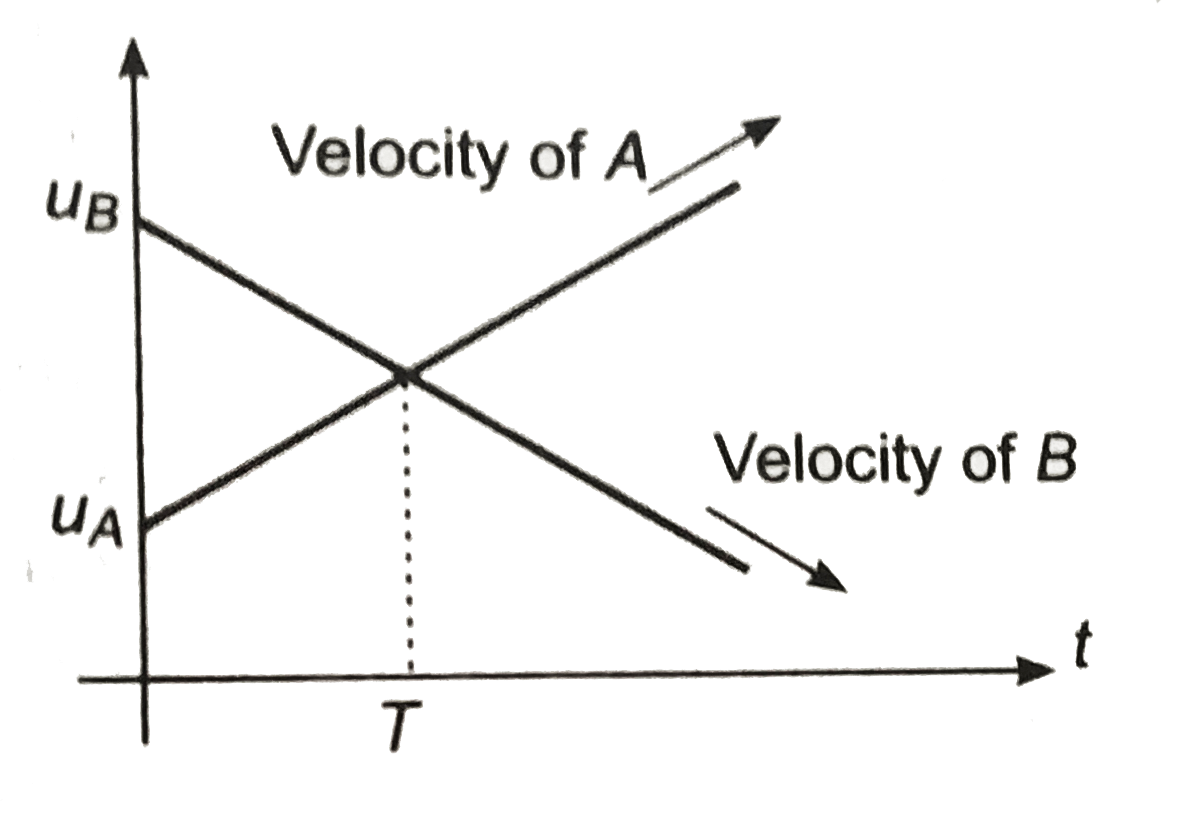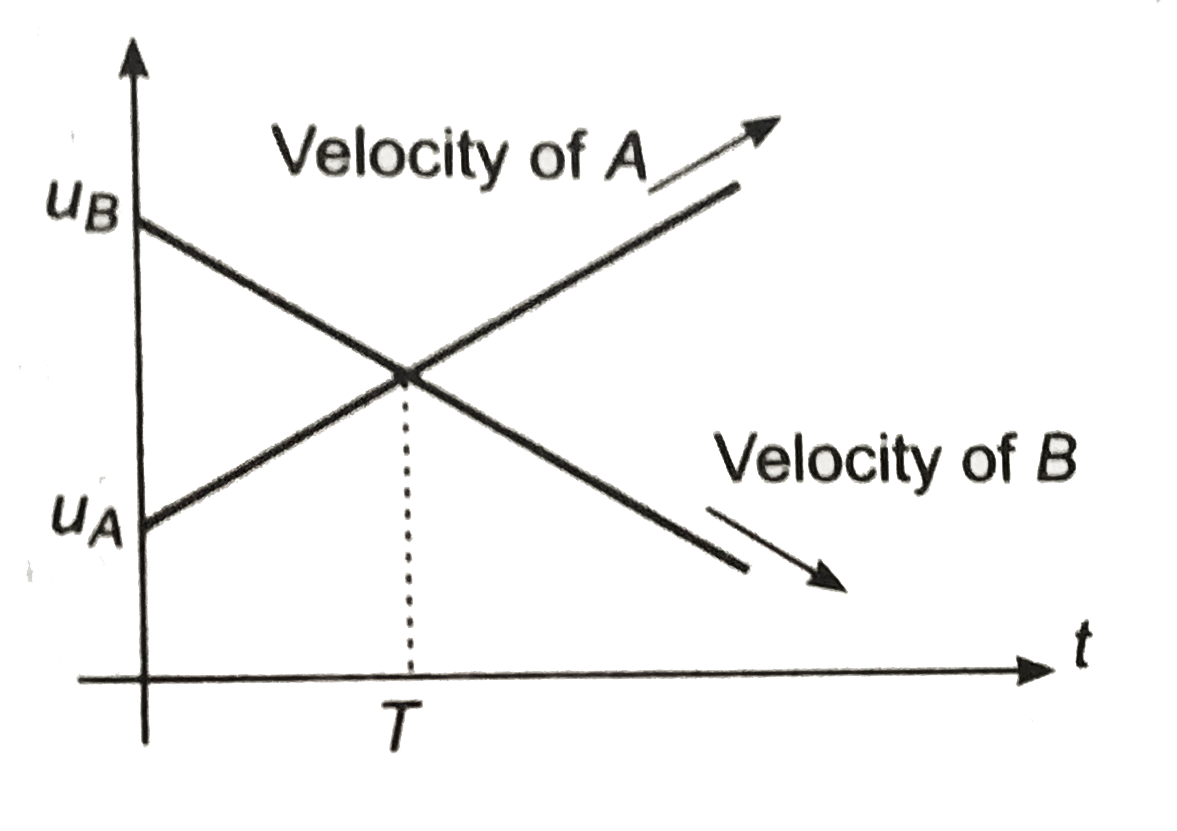A situation is shown in which two objects A and B start their motion from same point in same direction. The graph of their velocities against time is drawn. uAanduB are the initial velocities of A and B respectively. T is the time at which their velocities become equal after start of motion. You cannot use the data of one question while solving another question of the same set. So all the questions are independent of each other.
7. After 10 s of the start of motion of both objects A and B, find the value of velocity of A if uA=6ms−1,uB=12ms−1 and at T velocity of A is 8ms−1andT=4s

12ms−1
10ms−1
15ms−1
None of these
The correct Answer is:D
8=6+aAT=6+4aA
∴aA=0.5m/s
At 10s,
vA=uA+aAt
=(6)+(0.5)(10)
=11m/s
Topper's Solved these Questions
- KINEMATICSBOOK - DC PANDEYCHAPTER - KINEMATICSEXERCISE - Subjective Questions
24 Videos
- KINEMATICSBOOK - DC PANDEYCHAPTER - KINEMATICSEXERCISE - SCQ_TYPE
41 Videos
- KINEMATICSBOOK - DC PANDEYCHAPTER - KINEMATICSEXERCISE - More Than One Correct
6 Videos
- GRAVITATIONBOOK - DC PANDEYCHAPTER - GRAVITATIONEXERCISE - (C) Chapter Exercises
45 Videos
- KINEMATICS 1BOOK - DC PANDEYCHAPTER - KINEMATICS 1EXERCISE - INTEGER_TYPE
15 Videos
Similar Questions
Two cars A and B start from a same point at same instant of time and move in same direction. The variation of their respective velocities with time is indicated in the graph as shown in the figure. The time after their motion starts, when the cars cross each other is?
View SolutionTwo cars A and B start moving from the same point with same velocity v=5km/minute. Car A moves towards North and car B in moving towards East. What is the relative velocity of B with respect to A ?
View Solution
Knowledge Check
A situation is shown in which two objects A and B start their motion from same point in same direction. The graph of their velocities against time is drawn. uAanduB are the initial velocities of A and B respectively. T is the time at which their velocities become equal after start of motion. If the value of T is 4 s, then the time after which A will meet B is
 A12 sB6 sC8 sDdata insufficient
A12 sB6 sC8 sDdata insufficientA situation is shown in which two objects A and B start their motion from same point in same direction. The graph of their velocities against time is drawn. uAanduB are the initial velocities of A and B respectively. T is the time at which their velocities become equal after start of motion. You cannot use the data of one question while solving another question of the same set. So all the questions are independent of each other.
6. Let vAandvB be the velocities of the particles A and B respectively at the moment A and B meet after start of the motion. If uA=5ms−1anduB=15ms−1, then the magnitude of the difference of velocities vAandvB is
 A5ms−1B10ms−1C15ms−1Ddata insufficient
A5ms−1B10ms−1C15ms−1Ddata insufficientTwo particles A and B are thrown simu ltaneously from the same point at the same angle of projection but with the two different initial velocities (v+u) and (v-u) respectively. Which of the following statements will b e true in respect of their motions?
AThe difference in their maximum heights is (2uv/g)BThey reach their maximum heights at a time interval of (2usinθ)/gCThey will be separated by the distance of (2uvsin2θg) when they reach the ground againDThey are never in the same horizontal level during their flights.
At the start of a motion along a line the initial velocity is u and acceleration is at. The final velocity v after time t, is
View SolutionAt the start of a motion along a line the initial velocity is u and acceleration is at. The final velocity vafter time t, is
View SolutionTwo motor cars A and B start simultaneously from the same point on two straight roads at 60∘ to one another with velocity 30 and 40 km/h, respectively. The velocity of A with respect to B will be equal to
View SolutionAt the start of a motion along a line the initial velocity is u and acceleration is at. The final velocity v after timet, is
View SolutionA body moves with uniform velocity. Which of the graphs shown here is a graph of velocity against time for this motion?
View Solution
